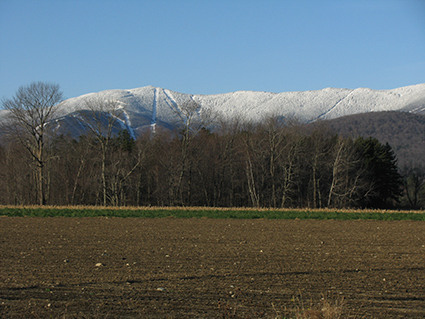
In Vermont, most farming takes place on hills, simply because that’s the state’s most common terrain. As a result, many of The Valley’s early community centers—such as Waitsfield Common—started out on hills.
The community centers have since moved down to the valley floor, but many of the farms are still on the hills and struggling to compete in today’s mass-produced market.
On Wednesday, December 12, the Mad River Valley Planning District (MRVPD) and its creation, the Mad River Valley Rural Resource Commission, hosted a public presentation titled “Hill Farming in the Mad River Valley: Past, Present and Future.”
The presentation was part of an ongoing study about what older farms are doing to adapt to today’s economy, how new farmers are entering the fold, how land conservation programs are helping and what new trends in state agriculture offer opportunities for farming in the Mad River Valley.
When completed, the study will include a history of hill farming in the Mad River Valley as well as a documentary film featuring interviews with today’s area farmers. Right now, the study is still a “work in progress,” MRVPD director Joshua Schwartz explained, but participants were happy to share their findings thus far.
“There is no perfect hill crop,” Lyssa Papazian said, starting out the historical component of the presentation, but she explained crops that do better in hilly areas include fruit, hay, pasture and dairy.
Back in the early 1800s, The Valley consisted primarily of sheep farms, but by the 1880s dairy farms had come to dominate. For the first half of the 20th century, dairy farms consolidated as a result of the wholesale fluid milk market, but by the 1960s, major changes in dairy farm regulations helped the shift back to the small, diversified farms that dot The Valley’s hills today.
Today, “we’re the largest operation here in town,” Dave DeFreest said of DeFreest Dairy Farm in Warren, “because we’re the only operation here in town.”
When Meg Campbell showed clips from her work-in-progress documentary, farmers like DeFreest got to share their perspectives on The Valley’s present state, as well as its future.
“There are some really well-educated, bright young people who are getting into agriculture,” Elwin Neill of Neill Farm in Waitsfield said.
For 26-year-old Marisa Mauro, who was recently selected by the Vermont Land Trust to start Ploughgate Creamery on Bragg Hill Farm, “It’s about working smarter, not harder,” she said, explaining how she and her young farming friends are constantly looking for ways to update outmoded practices to make farming more sustainable.
According to Dave Hartshorn, the owner of Hartshorn’s Certified Organic Farm in Waitsfield, the future of farming in the Mad River Valley “is more positive than it’s ever been,” he said, and in the next part of the presentation, director of Mad River Localvores Lisa Barnes accounted for some of that positivity by outlining the biggest trends she’s seen develop in The Valley’s agricultural sector in recent years.
Those trends include an increase in specialty crops, such as Vermont Yak Company’s yaks and Dana Forest Farm’s shitake mushrooms. Barnes has also noticed an increase in community supported agriculture, in which customers can purchase a share of a farm up front in exchange for fresh produce as it becomes available throughout the season.
Community supported agriculture “is a way to connect with a farm and share the responsibility,” Barnes explained, and Liza Walker’s following presentation explained how the Vermont Land Trust is also working to help farmers in sharing the responsibility.
For farmers in Vermont, the biggest obstacle is the availability and affordability of land, Walker explained, as the state is losing about 4,800 acres of land to development each year, and from 1990 to 2007, the average value of an acre of land in Vermont rose 351 percent, when the national average was only 299 percent.
To help offset these obstacles, the Vermont Land Trust is promoting land leasing programs, in which landowners who lease productive farmland to farmers can become eligible for reduced property tax rates, as well farmland access programs, which connect experienced farmers with opportunities to purchase farmland—like Marisa Mauro and Bragg Hill Farm.
{loadnavigation}





